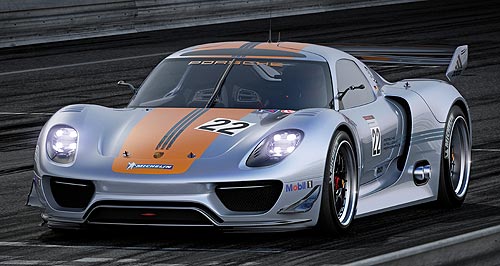Future models - Porsche - 918 - RSRDetroit show: Porsche puts a lid on 918 hybridGreen monster: With 570kW the 918 RSR demonstrates the performance potential of hybrid technology. Race-ready 918 RSR previews coupe version of Porsche’s hybrid supercar11 Jan 2011 A WILD 570kW hybrid racing sports car revealed by Porsche today at the Detroit motor show is thought to foreshadow the hardtop version of its forthcoming 918 hybrid super coupe. Although dressed with macho racing wings, race wheels and gaudy orange stripes, the 918 RSR essentially reveals the styling of a roofed 918 that is expected to go into production alongside the topless 918 Spyder hybrid roadster that was approved for production in mid-2010 following its debut in concept form at last year’s Geneva motor show. The track-ready 918 RSR combines the hybrid drivetrain from Porsche’s GT3 R Hybrid with a lightweight carbon fibre-reinforced plastic body in the shape of the production 918. Unlike the hybrid 918 Spyder, which uses lithium-ion batteries to power electric motors for extra motivation, the racy 918 RSR uses the GT3 R’s flywheel accumulator system developed with the Williams F1 team.  The flywheel stores energy from braking, spinning to 36,000rpm and then returning the energy in the form of electricity to electric motors at the front wheels. The flywheel stores energy from braking, spinning to 36,000rpm and then returning the energy in the form of electricity to electric motors at the front wheels.Each of the electric motors is said to be good for 75kW, for a total eight-second burst of 150kW of extra drive at the push of a button by the driver when overtaking or accelerating. The flywheel is charged when the two electric motors reverse their function in braking to generate electricity to spin an electric motor driving the flywheel. The main engine is a mid-mounted 420kW direct-injection V8 – a development of the Le Mans prototype RS Spyder’s race engine – so combined power for the car is 570kW. Porsche did not provide a torque figure, but expect it to be huge. The 918 RSR’s front electric drive system not only provides extra punch when required, but also helps to improve drive out of corners via a torque vectoring system that directs extra drive to the outside wheel for increased agility and improved steering response. As well, the hybrid system can be used to conserve fuel in long-distance races to cut the number of pit-stops. The petrol engine’s enormous power is transferred to the rear wheels through an upgraded, paddle-operated six-speed constant-mesh transmission with longitudinally-mounted shafts. The whole drivetrain is vastly different to that of the 918 Spyder, which is powered by a 3.4-litre V8 producing 370kW and three electric motors – two for the front wheels and one attached to the transmission to boost power to the rear wheels – with a total power of 163kW. Replacing the range-topping Carrera GT, the 918 Spyder is estimated to sprint to 100km/h in 3.2 seconds and sip just 3.0 litres of petrol per 100km. The 918 RSR’s design dispenses with the 918 Spyder’s conventional side-opening doors, replacing them with “wing doors” that swing vertically. Inside, the Spyder’s comfy interior has been stripped out for race readiness, with a single race seat and base console loaded with rocker switches. The flywheel accumulator is mounted in place of the passenger seat to the right of the console. Some aspects to the 918 RSR pay homage to Porsche racers of yore, with side air intakes in the rear wheel arches and a visible fan wheel in the centre of the engine cover among the hints of racers from the late 1960s and early 1970s. Even the number plastered on the flanks – 22 – harks back to Porsche’s win in the 1971 Le Mans 24 Hour.  Read more |
Click to sharePorsche modelsResearch Porsche Motor industry news |















Facebook Twitter Instagram